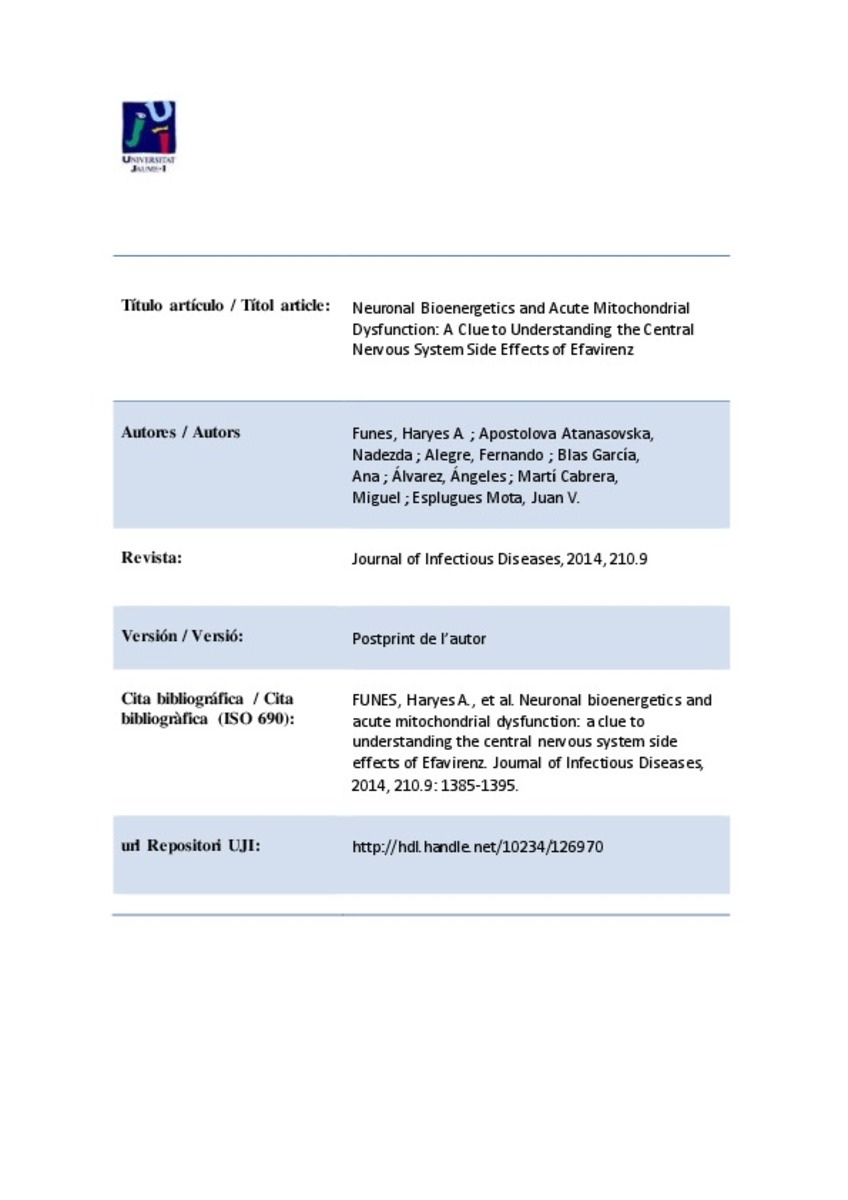Mostrar el registro sencillo del ítem
Neuronal Bioenergetics and Acute Mitochondrial Dysfunction: A Clue to Understanding the Central Nervous System Side Effects of Efavirenz
| dc.contributor.author | Funes, Haryes A. | |
| dc.contributor.author | Apostolova, Nadezda | |
| dc.contributor.author | Alegre, Fernando | |
| dc.contributor.author | Blas García, Ana | |
| dc.contributor.author | Álvarez, Ángeles | |
| dc.contributor.author | Martí Cabrera, Miguel | |
| dc.contributor.author | Esplugues Mota, Juan V. | |
| dc.date.accessioned | 2015-07-09T09:16:47Z | |
| dc.date.available | 2015-07-09T09:16:47Z | |
| dc.date.issued | 2014-05 | |
| dc.identifier.citation | FUNES, Haryes A., et al. Neuronal bioenergetics and acute mitochondrial dysfunction: a clue to understanding the central nervous system side effects of Efavirenz. Journal of Infectious Diseases, 2014, 210.9: 1385-1395. | ca_CA |
| dc.identifier.uri | http://hdl.handle.net/10234/126970 | |
| dc.description.abstract | Background. Neurological pathogenesis is associated with mitochondrial dysfunction and differences in neuronal/glial handling of oxygen and glucose. The main side effects attributed to efavirenz involve the CNS, but the underlying mechanisms are unclear. Methods. Human cell lines and rat primary cultures of neurons and astrocytes were treated with clinically relevant efavirenz concentration. Results. Efavirenz alters mitochondrial respiration, enhances reactive oxygen species generation, undermines mitochondrial membrane potential, and reduces adenosine triphosphate (ATP) levels in a concentration-dependent fashion in both neurons and glial cells. However, it activates adenosine monophosphate–activated protein kinase only in glial cells, upregulating glycolysis and increasing intracellular ATP levels, which do not occur in neurons. To reproduce the conditions that often exist in human immunodeficiency virus–related neuroinflammatory disorders, the effects of efavirenz were evaluated in the presence of exogenous nitric oxide, an inflammatory mediator and mitochondrial inhibitor. The combination potentiated the effects on mitochondrial parameters in both neurons and glial cells, but ATP generation and lactate production were enhanced only in glial cells. Conclusions. Efavirenz affects the bioenergetics of neurons through a mechanism involving acute mitochondrial inhibition, an action exacerbated in neuroinflammatory conditions. A similar scenario of glial cells survival and degeneration of neurons with signs of mitochondrial dysfunction and oxidative stress has been associated with neurocognitive disorders. | ca_CA |
| dc.format.extent | 10 p. | ca_CA |
| dc.format.mimetype | application/pdf | ca_CA |
| dc.language.iso | eng | ca_CA |
| dc.publisher | Oxford University Press | ca_CA |
| dc.relation.isPartOf | Journal of Infectious Diseases, 2014, 210.9 | ca_CA |
| dc.rights | © The Author 2014. Published by Oxford University Press on behalf of the Infectious Diseases Society of America. All rights reserved. | ca_CA |
| dc.rights.uri | http://rightsstatements.org/vocab/InC/1.0/ | * |
| dc.subject | mitochondria | ca_CA |
| dc.subject | HIV | ca_CA |
| dc.subject | neurotoxicity | ca_CA |
| dc.subject | central nervous system | ca_CA |
| dc.subject | efavirenz | ca_CA |
| dc.subject | nitric oxide | ca_CA |
| dc.subject | HIV-associated neurocognitive disorders | ca_CA |
| dc.title | Neuronal Bioenergetics and Acute Mitochondrial Dysfunction: A Clue to Understanding the Central Nervous System Side Effects of Efavirenz | ca_CA |
| dc.type | info:eu-repo/semantics/article | ca_CA |
| dc.identifier.doi | http://dx.doi.org/10.1093/infdis/jiu273 | |
| dc.rights.accessRights | info:eu-repo/semantics/openAccess | ca_CA |
| dc.relation.publisherVersion | http://jid.oxfordjournals.org/content/210/9/1385.short | ca_CA |
| dc.type.version | info:eu-repo/semantics/acceptedVersion |
Ficheros en el ítem
Este ítem aparece en la(s) siguiente(s) colección(ones)
-
MED_Articles [640]
Articles de publicacions periòdiques







